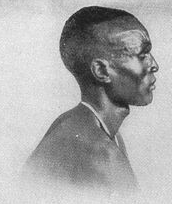This article has multiple issues.Please helpimprove itor discuss these issues on thetalk page.(Learn how and when to remove these messages)
|
TheDinka Malual,also known as theDinka Aweil,orMalual Tueng(Dinka: malual tueŋ), or justMalualjeernyang(Dinka: Malualgiɛrnyaŋ) are the largest subgroup of theDinka peopleresiding primarily in theNorthern Bahr el Ghazalregion ofSouth Sudan,particularly aroundAweil.They are part of the largerNiloticethnic group and are known for theirpastoralistlifestyle, rich cultural heritage, and historical resilience.[1]
History and Geography
editThe Dinka Malual have traditionally lived in thefloodplainsof Bahr el Ghazal, characterized by seasonal rivers and pastures suitable for cattle grazing.[2]Historically, they have faced numerous challenges, including displacement during theSecond Sudanese Civil Warand conflicts with neighboring groups such as theBaqqara Arabs.[3]
Culture and Society
editSocial Structure
editDinka Malual society is organized into clans and lineages, with elders playing a significant role in governance and conflict resolution.[4]
Language
editThey speak a dialect of theDinka language,part of theNilotic languagefamily.[5]
Religion
editTheir traditional beliefs include the worship of a high god,Nhialic,alongsideChristianity,which has spread in recent years.[6]
Economy
editThe Dinka Malual's economy is primarily based on cattle herding, agriculture, and fishing. The Aweil Dinka breed of cattle is notable for its smaller, finer build compared to other Dinka cattle breeds.[7]
Challenges
editThe Dinka Malual have faced significant challenges, including the Malual Dinka-Baqqara border conflict, which has impacted national integration and local stability.[8]Climate change,cattle raids, and displacement due to civil war have also affected their traditional way of life.[9]
Peace Efforts
editPeace initiatives, such as the Misseriya-Dinka Malual Peace Conference, supported by theUnited Nations Missions in South Sudan,aim to foster dialogue and reconciliation, addressing long-standing conflicts and promoting peaceful coexistence.[10]
References
edit- ^Deng, F. M. (1972).The Dinka of the Sudan.Waveland Press.
- ^Lienhardt, G. (1961).Divinity and Experience: The Religion of the Dinka.Oxford University Press.
- ^Beswick, S. (2004).Sudan's Blood Memory: The Legacy of War, Ethnicity, and Slavery in Early South Sudan.University of Rochester Press.
- ^Deng, F. M. (1987).The Man Called Deng Majok: A Biography of Power, Polygyny and Change.Yale University Press.
- ^Lienhardt, G. (1961).Divinity and Experience: The Religion of the Dinka.Oxford University Press.
- ^Deng, F. M. (1978).Dinka Cosmology.Khartoum University Press.
- ^Deng, F. M. (1984).The Dinka and Their Songs.Oxford University Press.
- ^Johnson, D. H. (1994).Divinity, Meaningfulness, and Symbolic Exchange in Dinka Bor Thought.Africa, 64(4), 581-598.
- ^Jok, J. M. (1999). "Militarization and Gender Violence in South Sudan." Journal of Asian and African Studies, 34(4), 427-442.
- ^Ryle, J. (2011).A History of the Dinka of South Sudan.Oxford University Press.
Further reading
edit- Deng, F. M. (1972).The Dinka of the Sudan.Waveland Press.
- Lienhardt, G. (1961).Divinity and Experience: The Religion of the Dinka.Oxford University Press.
- Deng, F. M. (1978).Dinka Cosmology.Khartoum University Press.
- Deng, F. M. (1984).The Dinka and Their Songs.Oxford University Press.
- Deng, F. M. (1987).The Man Called Deng Majok: A Biography of Power, Polygyny and Change.Yale University Press.
- Johnson, D. H. (1994).Divinity, Meaningfulness, and Symbolic Exchange in Dinka Bor Thought.Africa, 64(4), 581–598.
- Beswick, S. (2004).Sudan's Blood Memory: The Legacy of War, Ethnicity, and Slavery in Early South Sudan.University of Rochester Press.
- Jok, J. M. (1999). "Militarization and Gender Violence in South Sudan." Journal of Asian and African Studies, 34(4), 427–442.
- Ryle, J. (2011).A History of the Dinka of South Sudan.Oxford University Press.
- Deng, F. M. (1995).War of Visions: Conflict of Identities in the Sudan.Brookings Institution Press.
- Hutchinson, S. E. (1996).Nuer Dilemmas: Coping with Money, War, and the State.University of California Press.
- Hutchinson, S. E. (2001). "A Curse from God? Religious and Political Dimensions of the Post-1991 Rise of Ethnic Violence in South Sudan." The Journal of Modern African Studies, 39(2), 307–331.
- Beswick, S. (2010). "Genocide and the Politics of Memory: Studying Death to Preserve Life in Rwanda and South Sudan." Africa Today, 57(2), 3-24.
- Topić, N. (2011).The Dinka of South Sudan: Resilience and Adaptation in a Changing Environment.Routledge.
